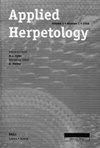L. Harden, S. E. Pittman, J. Gibbons, M. Dorcas
{"title":"利用头数调查快速评估菱形龟(Malaclemys terrapin)数量的技术发展","authors":"L. Harden, S. E. Pittman, J. Gibbons, M. Dorcas","doi":"10.1163/157075408X397527","DOIUrl":null,"url":null,"abstract":"Although diamondback terrapins appear to be declining throughout much of their geographic range, more information is required to evaluate population trends. Unfortunately, sampling terrapin populations is both time and labor intensive. We initiated studies to examine the efficacy of using head counts in tidal creeks as a rapid-assessment technique for monitoring terrapin populations. From 2005 to 2007, we conducted headcount surveys in conjunction with regular aquatic sampling. Head-count surveys consisted of recording the number of terrapins we observed from a boat going up (run 1) and down (run 2) tidal creeks. These surveys were conducted before aquatic sampling (i.e., low tide) as well as other times (e.g., high tide). We found the strongest positive relationship between the number of terrapins observed in run 1 combined with run 2 and the number of terrapins captured (R 2 = 0.538). We examined the effects of variables such as day of year, time of day, cloud cover, and creek location on the number of heads seen. Such models will allow effective monitoring of terrapin population trends and improve implementation of appropriate conservation measures. We recommend a refinement of head-count surveys and the involvement of citizen scientists to aid in the establishment of a range-wide monitoring program that will greatly increase survey effort while saving time and money. © Koninklijke Brill NV, Leiden, 2009","PeriodicalId":55499,"journal":{"name":"Applied Herpetology","volume":"6 1","pages":"237-245"},"PeriodicalIF":0.0000,"publicationDate":"2009-01-01","publicationTypes":"Journal Article","fieldsOfStudy":null,"isOpenAccess":false,"openAccessPdf":"https://sci-hub-pdf.com/10.1163/157075408X397527","citationCount":"19","resultStr":"{\"title\":\"Development of a rapid-assessment technique for diamondback terrapin ( Malaclemys terrapin ) populations using head-count surveys\",\"authors\":\"L. Harden, S. E. Pittman, J. Gibbons, M. Dorcas\",\"doi\":\"10.1163/157075408X397527\",\"DOIUrl\":null,\"url\":null,\"abstract\":\"Although diamondback terrapins appear to be declining throughout much of their geographic range, more information is required to evaluate population trends. Unfortunately, sampling terrapin populations is both time and labor intensive. We initiated studies to examine the efficacy of using head counts in tidal creeks as a rapid-assessment technique for monitoring terrapin populations. From 2005 to 2007, we conducted headcount surveys in conjunction with regular aquatic sampling. Head-count surveys consisted of recording the number of terrapins we observed from a boat going up (run 1) and down (run 2) tidal creeks. These surveys were conducted before aquatic sampling (i.e., low tide) as well as other times (e.g., high tide). We found the strongest positive relationship between the number of terrapins observed in run 1 combined with run 2 and the number of terrapins captured (R 2 = 0.538). We examined the effects of variables such as day of year, time of day, cloud cover, and creek location on the number of heads seen. Such models will allow effective monitoring of terrapin population trends and improve implementation of appropriate conservation measures. We recommend a refinement of head-count surveys and the involvement of citizen scientists to aid in the establishment of a range-wide monitoring program that will greatly increase survey effort while saving time and money. © Koninklijke Brill NV, Leiden, 2009\",\"PeriodicalId\":55499,\"journal\":{\"name\":\"Applied Herpetology\",\"volume\":\"6 1\",\"pages\":\"237-245\"},\"PeriodicalIF\":0.0000,\"publicationDate\":\"2009-01-01\",\"publicationTypes\":\"Journal Article\",\"fieldsOfStudy\":null,\"isOpenAccess\":false,\"openAccessPdf\":\"https://sci-hub-pdf.com/10.1163/157075408X397527\",\"citationCount\":\"19\",\"resultStr\":null,\"platform\":\"Semanticscholar\",\"paperid\":null,\"PeriodicalName\":\"Applied Herpetology\",\"FirstCategoryId\":\"1085\",\"ListUrlMain\":\"https://doi.org/10.1163/157075408X397527\",\"RegionNum\":0,\"RegionCategory\":null,\"ArticlePicture\":[],\"TitleCN\":null,\"AbstractTextCN\":null,\"PMCID\":null,\"EPubDate\":\"\",\"PubModel\":\"\",\"JCR\":\"\",\"JCRName\":\"\",\"Score\":null,\"Total\":0}","platform":"Semanticscholar","paperid":null,"PeriodicalName":"Applied Herpetology","FirstCategoryId":"1085","ListUrlMain":"https://doi.org/10.1163/157075408X397527","RegionNum":0,"RegionCategory":null,"ArticlePicture":[],"TitleCN":null,"AbstractTextCN":null,"PMCID":null,"EPubDate":"","PubModel":"","JCR":"","JCRName":"","Score":null,"Total":0}
引用次数: 19
Development of a rapid-assessment technique for diamondback terrapin ( Malaclemys terrapin ) populations using head-count surveys
Although diamondback terrapins appear to be declining throughout much of their geographic range, more information is required to evaluate population trends. Unfortunately, sampling terrapin populations is both time and labor intensive. We initiated studies to examine the efficacy of using head counts in tidal creeks as a rapid-assessment technique for monitoring terrapin populations. From 2005 to 2007, we conducted headcount surveys in conjunction with regular aquatic sampling. Head-count surveys consisted of recording the number of terrapins we observed from a boat going up (run 1) and down (run 2) tidal creeks. These surveys were conducted before aquatic sampling (i.e., low tide) as well as other times (e.g., high tide). We found the strongest positive relationship between the number of terrapins observed in run 1 combined with run 2 and the number of terrapins captured (R 2 = 0.538). We examined the effects of variables such as day of year, time of day, cloud cover, and creek location on the number of heads seen. Such models will allow effective monitoring of terrapin population trends and improve implementation of appropriate conservation measures. We recommend a refinement of head-count surveys and the involvement of citizen scientists to aid in the establishment of a range-wide monitoring program that will greatly increase survey effort while saving time and money. © Koninklijke Brill NV, Leiden, 2009

 求助内容:
求助内容: 应助结果提醒方式:
应助结果提醒方式:


